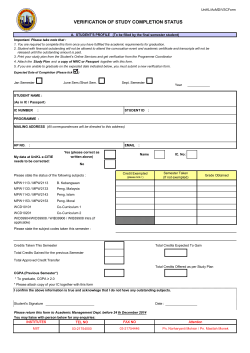
l1 - Informatik 2 - RWTH Aachen University
Semantics and Verification of Software
Summer Semester 2015
Lecture 1: Introduction
Thomas Noll
Software Modeling and Verification Group
RWTH Aachen University
http://moves.rwth-aachen.de/teaching/ss-15/sv-sw/
Preliminaries
Staff
• Lectures: Thomas Noll
– Lehrstuhl fur
¨ Informatik 2, Room 4211
– E-mail noll@cs.rwth-aachen.de
• Exercise classes:
– Christoph Matheja (matheja@cs.rwth-aachen.de)
– Federico Olmedo (federico.olmedo@cs.rwth-aachen.de)
• Student assistants:
– Frederick Prinz
3 of 18
Semantics and Verification of Software
Summer Semester 2015
Lecture 1: Introduction
Preliminaries
Target Audience
• MSc Informatik:
– Theoretische Informatik
• MSc Software Systems Engineering:
– Theoretical Foundations of SSE
• In general:
– interest in formal models for programming languages
– application of mathematical reasoning methods
• Expected: basic knowledge in
– essential concepts of imperative programming languages
– formal languages and automata theory
– mathematical logic
4 of 18
Semantics and Verification of Software
Summer Semester 2015
Lecture 1: Introduction
Preliminaries
Organisation
• Schedule:
– Lecture Tue 14:15–15:45 AH 2 (starting 14 April)
– Lecture Thu 11:15–12:45 AH 2 (starting 9 April)
– Exercise class Wed 15:00–16:30 AH 6 (starting 22 April)
• Irregular lecture dates – checkout web page!
• Introductory exercise on 22 April
• 1st assignment sheet: next Wednesday (15 April) on web page
– submission by 22 April
– presentation on 29 April
• Work on assignments in groups of three
• Examination (6 ECTS credits):
– oral or written (depending on number of participants)
– date to be fixed
• Admission requires at least 50% of the points in the exercises
• Written material in English, lecture and exercise classes “on demand”, rest up to you
5 of 18
Semantics and Verification of Software
Summer Semester 2015
Lecture 1: Introduction
Introduction
Aspects of Programming Languages
Syntax: “How does a program look like?”
• hierarchical composition of programs from structural components
⇒ Compiler Construction
Semantics: “What does this program mean?”
• output/behaviour/... in dependence of input/environment/...
⇒ This course
Pragmatics: • length and understandability of programs
• learnability of programming language
• appropriateness for specific applications, ...
⇒ Software Engineering
Historic development:
• Formal syntax since 1960s (scanners, LL/LR parsers);
semantics defined by compiler/interpreter
• Formal semantics since 1970s
(operational/denotational/axiomatic)
7 of 18
Semantics and Verification of Software
Summer Semester 2015
Lecture 1: Introduction
Introduction
Why Semantics?
Idea: compiler = ultimate semantics!
• Compiler gives each individual program a semantics
(= “behaviour” of generated machine code)
But:
• Compilers are highly complicated software systems
–
–
–
–
code optimisations
memory management
interaction with runtime system
...
• Most languages have more than one compiler (with different outputs)
• Most compilers have bugs
⇒ Does not help with formal reasoning about programming language or individual programs
8 of 18
Semantics and Verification of Software
Summer Semester 2015
Lecture 1: Introduction
Introduction
The Semantics of “Semantics”
Originally: study of meaning of symbols (linguistics)
Semantics of a program: meaning of a concrete program
• mapping input → output values
• interaction behaviour (shared variables, communication, ...)
• ...
Semantics of a programming language: mapping of each (syntactically correct)
program of a concrete programming language to its meaning
Semantics of software: various techniques for defining the semantics of diverse
programming languages
• operational
• denotational
• axiomatic
• ...
9 of 18
Semantics and Verification of Software
Summer Semester 2015
Lecture 1: Introduction
Introduction
Motivation for Rigorous Formal Treatment I
Example 1.1
1. How often will the following loop be traversed?
for i := 2 to 1 do ...
FORTRAN IV: once
PASCAL: never
2. What if p = nil in the following program?
while p <> nil and p^.key < val do ...
Pascal: strict boolean operations
Modula: non-strict boolean operations X
10 of 18
Semantics and Verification of Software
Summer Semester 2015
Lecture 1: Introduction
Introduction
Motivation for Rigorous Formal Treatment II
• Support for development of
– new programming languages: missing details, ambiguities and inconsistencies can be recognized
– compilers: automatic compiler generation from appropriately defined semantics
– programs: exact understanding of semantics avoids uncertainties in the implementation of
algorithms
• Support for correctness proofs of
– programs: comparison of program semantics with desired behavior
(e.g., termination properties, absence of deadlocks, ...)
compiler
−→ machine code
semantics ↓
↓ (simple) semantics
?
meaning
= meaning
optimization
– optimizing transformations:
code
−→ code
semantics ↓
↓ semantics
?
meaning
=
meaning
– compilers: programming language
11 of 18
Semantics and Verification of Software
Summer Semester 2015
Lecture 1: Introduction
Introduction
(Complementary) Kinds of Formal Semantics
Operational semantics: describes computation of the program on some (very)
abstract machine (G. Plotkin)
hc1, σi → σ 0 hc2, σ 0i → σ 00
• example: (seq)
hc1;c2, σi → σ 00
• application: implementation of programming languages (compilers, interpreters, ...)
Denotational semantics: mathematical definition of input/output relation of the
program by induction on its syntactic structure (D. Scott, C. Strachey)
• example: CJ.K : Cmd → (Σ 99K Σ)
CJc1;c2K := CJc2K ◦ CJc1K
• application: program analysis
Axiomatic semantics: formalization of special properties of programs by logical
formulae (assertions/proof rules; R. Floyd, T. Hoare)
{A} c1 {C } {C } c2 {B }
• example: (seq)
{A} c1;c2 {B }
• application: program verification
12 of 18
Semantics and Verification of Software
Summer Semester 2015
Lecture 1: Introduction
Introduction
Overview of the Course
1. The imperative model language WHILE
2. Operational semantics of WHILE
3. Denotational semantics of WHILE
4. Equivalence of operational and denotational semantics
5. Axiomatic semantics of WHILE
6. Extensions: procedures and dynamic data structures
7. Applications: compiler correctness etc.
13 of 18
Semantics and Verification of Software
Summer Semester 2015
Lecture 1: Introduction
Introduction
Literature
(also see the collection [“Handapparat”] at the CS Library)
• Formal semantics
– G. Winskel: The Formal Semantics of Programming Languages, The MIT Press, 1996
• Compiler correctness
– H.R. Nielson, F. Nielson: Semantics with Applications: An Appetizer , Springer Undergraduate Topics
in Computer Science, 2007
14 of 18
Semantics and Verification of Software
Summer Semester 2015
Lecture 1: Introduction
The Imperative Model Language WHILE
Syntactic Categories
WHILE: simple imperative programming language without procedures or advanced
data structures
Syntactic categories:
Category
Numbers
Truth values
Variables
Arithmetic expressions
Boolean expressions
Commands (statements)
16 of 18
Semantics and Verification of Software
Summer Semester 2015
Lecture 1: Introduction
Domain
Z = {0, 1, −1, . . .}
B = {true, false}
Var = {x, y, . . .}
AExp (next slide)
BExp (next slide)
Cmd (next slide)
Meta variable
z
t
x
a
b
c
The Imperative Model Language WHILE
Syntax of WHILE Programs
Definition 1.2 (Syntax of WHILE)
The syntax of WHILE Programs is defined by the following context-free grammar:
a ::= z | x | a1+a2 | a1-a2 | a1*a2 ∈ AExp
b ::= t | a1=a2 | a1>a2 | ¬b | b1 ∧ b2 | b1 ∨ b2 ∈ BExp
c ::= skip | x := a | c1;c2 | if b then c1 else c2 end | while b do c end ∈ Cmd
Remarks: we assume that
• the syntax of numbers, truth values and variables is predefined
(i.e., no “lexical analysis”)
• the syntactic interpretation of ambiguous constructs (expressions) is uniquely determined
(by brackets or priorities)
17 of 18
Semantics and Verification of Software
Summer Semester 2015
Lecture 1: Introduction
The Imperative Model Language WHILE
A WHILE Program and Its Flow Diagram
Example 1.3
x := 6;
y := 7;
z := 0;
while x > 0 do
x := x - 1;
v := y;
while v > 0 do
v := v - 1;
z := z + 1
end
end
Effect: z := x * y = 42
18 of 18
Semantics and Verification of Software
Summer Semester 2015
Lecture 1: Introduction
© Copyright 2025











